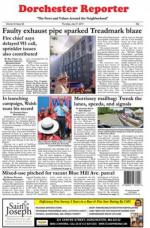July 10, 2019
By Lew Finfer
Special to the Reporter
The public television’s show “This Old House” turned 40 this year. The first house featured in the program’s pilot — a beautiful, stately home at the corner of Bowdoin and Percival Streets near St. Peter’s Church— was vacant at the time. The home was beautifully restored and it remains a jewel in the neighborhood under the care of its current owners.
But, there’s much more to the story of how it became vacant in the first place. Before it was acquired by WGBH-TV, it was the home of Earl Perkins, a Korean War veteran who led the Meeting House Hill Civic Association that met monthly nearby at the First Parish Church. Like civic leaders across the city, Earl devoted his time to lead these groups, get residents together, react to problems they see, and try to get city agencies and elected officials to respond.
But when Earl lost his job unexpectedly, he faced mounting problems that so many of his neighbors also encountered in that era. In the 1970s, Dorchester was plagued by hundreds and hundreds of abandoned buildings. Bank redlining schemes meant it was harder to get financing for many. It was impossible to get loans in parts of Dorchester because lenders said parts of the neighborhood were deteriorating, which was often due in part to banks refusing to offer loans for home-improvements.
At the time, I was an organizer for Dorchester Community Action Council, which then became Dorchester Fair Share.
Abandoned buildings were a big issue for us, because they were frequent targets for arsonists. The fires endangered nearby buildings and the people who lived there. They were also targets for vandals and thieves. And, the results lowered property values for everyone.
In 1974, we convened a public meeting with Mayor Kevin White on the topic of abandoned buildings in Meeting House Hill/Bowdoin-Geneva. In front of 300 people, we showed him a slide show. The mayor who said he used to “date a girl on Barry Street” — was taken aback at the blight. We gave him a list of over 60 abandoned buildings and asked the city to tear them down. He agreed to do that. We had a similar meeting in 1975 with federal HUD officials asking them to tear down houses they owned through foreclosure.
In 1976, we asked Boston Housing Court Chief Justice Paul Garitty (not the federal Judge Arthur Garitty, who is known for the 1974 desegregation and busing decision ) to hold an unprecedented, evening session to hear cases against owners of abandoned buildings that were not secured. The court session was held at St. Ambrose Church in Fields Corner. Earl Perkins owned one of these houses, a three decker in Codman Square. He made efforts to keep it secured, but people broke into it repeatedly.
Earl faced foreclosure on his Meeting House Hill home when he lost his job. His wife called me to see if anything could be done. I understood it must have been very hard to call someone like me, but she was so concerned about her home.
I checked with Legal Services, but the Perkins’ did not have an FHA insured mortgage so there was not a forbearance policy option available that might have saved them. Sadly, they had to leave their beautiful home on the hill.
Lew Finfer is a community organizer and Dorchester resident. He’s with the Dorchester based Massachusetts Communities Action Network.


